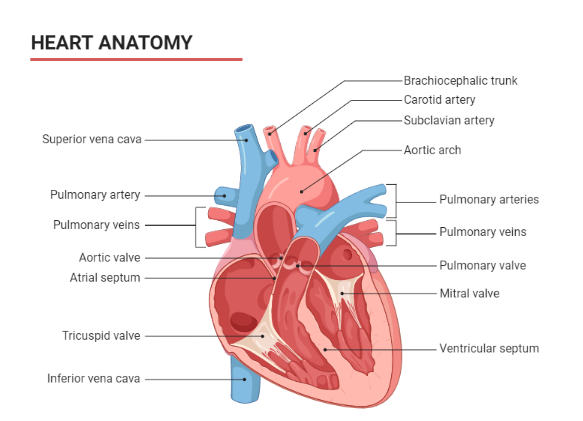
What are the names of three layers of the heart wall?
Answer
415.8k+ views
Hint: In many animals, the heart is a muscular organ that pumps the blood across its veins. The blood that is pumped transports oxygen and supplements into the body, while transporting metabolic waste to the lungs such as carbon dioxide.
Complete answer:
Connective tissue, endothelium, and cardiovascular muscle comprise the heart wall. It is the cardiovascular muscle that allows the heart to contract and considers heartbeat synchronisation. The epicardium, myocardium, and endocardium are the three layers of the heart divider.
The epicardium is the heart's external defensive layer.
Myocardium: the heart's strong centre layer mass.
The endocardium is the heart's internal layer.

Epicardium (epi-cardium) is the external layer of the heart wall. It is otherwise called instinctive pericardium as it frames the internal layer of the pericardium. The epicardium is made basically out of free connective tissue, including flexible filaments and fat tissue.
Myocardium (myo-cardium) is the center layer of the heart wall. It is made out of cardiovascular muscle strands, which empower heart compressions. The myocardium is the thickest layer of the heart wall, with its thickness shifting in various pieces of the heart. The myocardium of the left ventricle is the thickest, as this ventricle is answerable for producing the force expected to pump oxygenated blood from the heart to the remainder of the body. Cardiovascular muscle withdrawals are heavily influenced by the fringe sensory system, which coordinates compulsory capacities including pulse.
Endocardium (endo-cardium) is the sensitive internal layer of the heart divider. This layer lines the internal heart chambers, covers heart valves, and is constant with the endothelium of huge veins. The endocardium of the heart atria consists of smooth muscle, just as flexible filaments.
Note:
A contamination of the endocardium can prompt a condition known as endocarditis. Endocarditis is ordinarily the consequence of a disease of the heart valves or endocardium by specific microorganisms, parasites, or different organisms. Endocarditis is a genuine condition that can be lethal.
Complete answer:
Connective tissue, endothelium, and cardiovascular muscle comprise the heart wall. It is the cardiovascular muscle that allows the heart to contract and considers heartbeat synchronisation. The epicardium, myocardium, and endocardium are the three layers of the heart divider.
The epicardium is the heart's external defensive layer.
Myocardium: the heart's strong centre layer mass.
The endocardium is the heart's internal layer.

Epicardium (epi-cardium) is the external layer of the heart wall. It is otherwise called instinctive pericardium as it frames the internal layer of the pericardium. The epicardium is made basically out of free connective tissue, including flexible filaments and fat tissue.
Myocardium (myo-cardium) is the center layer of the heart wall. It is made out of cardiovascular muscle strands, which empower heart compressions. The myocardium is the thickest layer of the heart wall, with its thickness shifting in various pieces of the heart. The myocardium of the left ventricle is the thickest, as this ventricle is answerable for producing the force expected to pump oxygenated blood from the heart to the remainder of the body. Cardiovascular muscle withdrawals are heavily influenced by the fringe sensory system, which coordinates compulsory capacities including pulse.
Endocardium (endo-cardium) is the sensitive internal layer of the heart divider. This layer lines the internal heart chambers, covers heart valves, and is constant with the endothelium of huge veins. The endocardium of the heart atria consists of smooth muscle, just as flexible filaments.
Note:
A contamination of the endocardium can prompt a condition known as endocarditis. Endocarditis is ordinarily the consequence of a disease of the heart valves or endocardium by specific microorganisms, parasites, or different organisms. Endocarditis is a genuine condition that can be lethal.
Recently Updated Pages
Master Class 11 Economics: Engaging Questions & Answers for Success

Master Class 11 Business Studies: Engaging Questions & Answers for Success

Master Class 11 Accountancy: Engaging Questions & Answers for Success

Master Class 11 English: Engaging Questions & Answers for Success

Master Class 11 Computer Science: Engaging Questions & Answers for Success

Master Class 11 Maths: Engaging Questions & Answers for Success

Trending doubts
Why was the Vernacular Press Act passed by British class 11 social science CBSE

Name the nuclear plant located in Uttar Pradesh class 11 social science CBSE

What steps did the French revolutionaries take to create class 11 social science CBSE

One Metric ton is equal to kg A 10000 B 1000 C 100 class 11 physics CBSE

How did silk routes link the world Explain with three class 11 social science CBSE

Difference Between Prokaryotic Cells and Eukaryotic Cells




